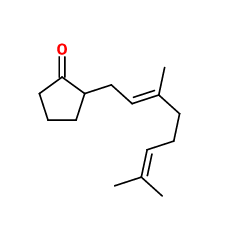
Photo credits: ScenTree SAS
Do you sell any of the raw materials? Would you like to let our users know?
Send an email to fournisseurs@scentree.coto learn about our advertising opportunities.
Do you sell any of the raw materials? Would you like to let our users know?
Send an email to fournisseurs@scentree.coto learn about our advertising opportunities.
General Presentation
-
CAS N° : 68133-79-9
-
EINECS number : 268-706-3
-
FEMA number : 3829
-
FLAVIS number : 07.257
-
JECFA number : 1117
-
Appearance : Pale yellow liquid
-
Density : 0,915
-
Volatility : Heart/Base
-
Price Range : €€€
Physico-chemical properties
-
Molecular formula : C15H24O
-
Molecular Weight : 220,35 g/mol
-
Log P : 5,15
-
Fusion Point : Donnée indisponible.
-
Boiling Point : 130°C
-
Detection Threshold : Donnée indisponible.
-
Optical rotation : Donnée indisponible
-
Vapor pressure : Donnée indisponible
-
Refractive Index @20°C : Donnée indisponible
-
Acid Value : Donnée indisponible.
-
Flash Point : 139°C
Uses
Uses in perfumery :
Usually used in fruity notes such as apricot or peach. It is also interesting when used in harmony with floral notes such as rose because it has facets close to rose ketones.
Year of discovery :
1955
Natural availability :
Apritone® is not available in its natural state.
Isomerism :
Apritone® has a double bond source of a diastereomer. Only its trans (E) isomer is used in perfumery.
Synthesis precursor :
Apritone® is not a precursor to the synthesis of another compound of olfactory interest.
Synthesis route :
Data not available.
Regulations & IFRA
Allergens :
This ingredient does not contain any allergen.
IFRA 51th :
This ingredient is not restricted for the 51th amendment


